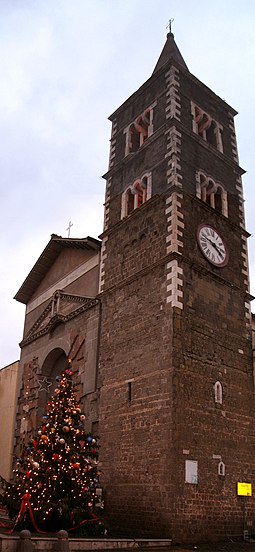

Suburbicarian Diocese of Palestrina
Praenestina
| |
|---|---|

Palestrina Cathedral
| |
| Location | |
| Country | Italy |
| Ecclesiastical province | Rome |
| Statistics | |
| Area | 380 km2 (150 sq mi) |
| Population - Total - Catholics | (as of 2004) 113,000 (est.) 110,500 (est.) (97.8%) |
| Parishes | 49 |
| Information | |
| Denomination | Catholic Church |
| Rite | Roman Rite |
| Established | 4th century |
| Cathedral | Basilica Cattedrale di S. Agapito Martire |
| Secular priests | 54 (diocesan) 46 (Religious Orders) |
| Current leadership | |
| Pope | Francis |
| Bishop | Domenico Sigalini |
| Map | |
 | |
| Website | |
| www.diocesipalestrina.it | |
The Suburbicarian Diocese of Palestrina (Latin: Diocesis Praenestina) is a Latin suburbicarian diocese centered on the comuneofPalestrina in Italy.
The current bishop of Palestrina is Domenico Sigalini, who from 3 November 2010 until 5 April 2014 was also appointed by Pope Benedict XVI to be the general ecclesiastical assistant of Italian Catholic Action.
This section needs expansion. You can help by adding to it. (October 2016)
|
Palestrina was looted in 1473.[1]
During the 17th century, the comune of Palestrina was the family territory of a number of Italian noble families including the Barberini, Colonna and d'Este families (which regularly intermarried). Members of these families are represented throughout the list of diocese Bishops, especially between 1600 and 1800. Barberini Pope Urban VIII appointed a number of relatives and close supporters to the Palestrina diocese and governmental positions.

Like all dioceses in this category, for historical reasons it has had, since 1960, an incumbent diocesan bishop with ordinary powers but also has assigned to it as an honorary high ranking dignity one of the six cardinals in the Order of Cardinal Bishops.[26] The Cardinal Bishop has no powers with regard to the government of the diocese.[citation needed]
The diocesan bishops have been:[27]
{{cite book}}: |first1= has generic name (help) p. 80. (in Latin)